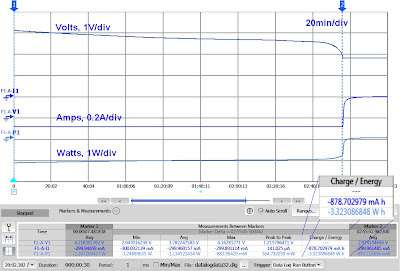One aspect (of many) I have talked about for optimizing
battery life for battery powered mobile devices is assessing the battery’s
actual capacity. Not only do you need to assess its capacity under conditions
as stated by the manufacturer but also under conditions reflecting actual end
use.
Validating the battery under a manufacturer’s stated
conditions establish a starting point of what you might be achievable in how
much capacity you can obtain from the battery and if it is in line with what
the manufacturer states. Sometime it can be less for a variety of reasons. Even
subtle differences in stated conditions can lead to fairly substantial
differences in capacity. The stated conditions usually provide a “best case”
achievable value for capacity. Do not be surprised if your results for the
battery’s capacity fall a little short of the best case value provided by the
manufacturer. With a little work you may be able to determine what subtle
difference caused it, or simply, the best case value given is a bit optimistic.
Validating the battery under end-use conditions helps
establish the difference you can expect between the battery’s capacity for
rather ideal stated conditions against end-use conditions. Battery powered
mobile devices draw current in a pulsed fashion, with high peaks in relation to
the overall average current drain. An example of this kind of dynamic current
drain is shown in Figure 1. In this case it is the active mode current drain of
a GPRS smart mobile phone.
Figure 1: GPRS smart mobile phone dynamic current drain
waveform
This usually significantly degrades the battery’s
delivered capacity in comparison to the manufacturer’s stated conditions, which
are based on a constant DC current discharge. If you do not take the impact of
end-use loading conditions on the battery’s capacity into account there is a
good chance the mobile device’s run-time will fall quite a bit short of
expectations.
The usual way to validate a battery’s capacity under
end-use conditions is to actually hook the battery together with its device,
connect up logging instrumentation for recording the battery run down voltage
and current over time, and then placing the device in a desired operating mode
and let it run until the battery is run down. While a battery run-down test
like this is useful to do it has a couple of issues when trying to focus explicitly on
just the battery:
- It is a test of the combination of the battery together with its host device. The host device also has influence on the test’s outcome and must be taken into account in assessing just the battery under end-use.
- It can often be complex and difficult to set up the device in its desired operating condition, requiring a substantial amount of supporting equipment to recreate its environment for providing a realistic operating condition.
- It can sometimes be difficult to get consistently repeatable results with the actual device.
An alternative to repeatedly using the actual device is
to use an electronic load that can draw a dynamic current representative of the
actual device the electronic load is being used in place of. In some cases a
simple low duty cycle, high crest factor pulsed current waveform can be
directly programmed into the electronic load. In cases where the host device’s
current drain waveform is a bit more complex it may be useful to have an
electronic load that is able to “play back” a digitized waveform file that is a
representative portion of the device’s actual current drain, on an ongoing
basis to run down the battery. As one example we put features into our 14585A
software to simplify this record and playback approach using our N6781A
2-quadrant DC source measure module. This set up is depicted in Figure 2.
Figure 2: Current drain record and playback set up using
the 14585 and N6781A






